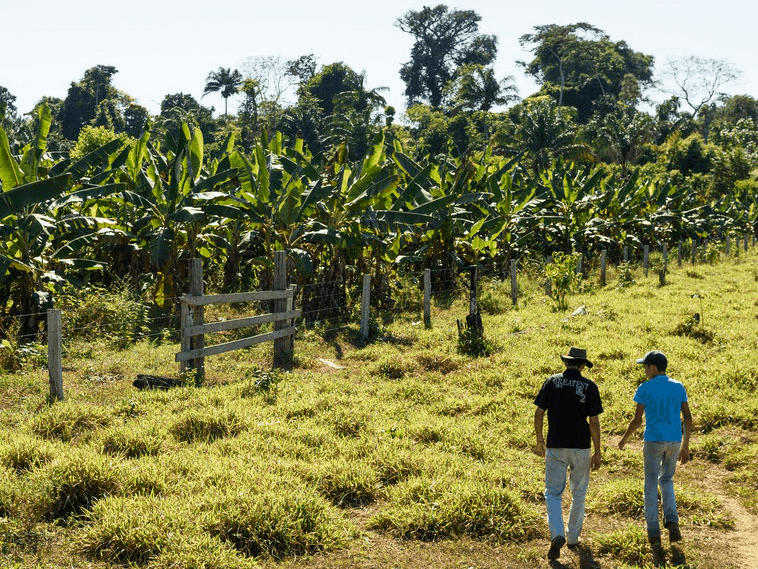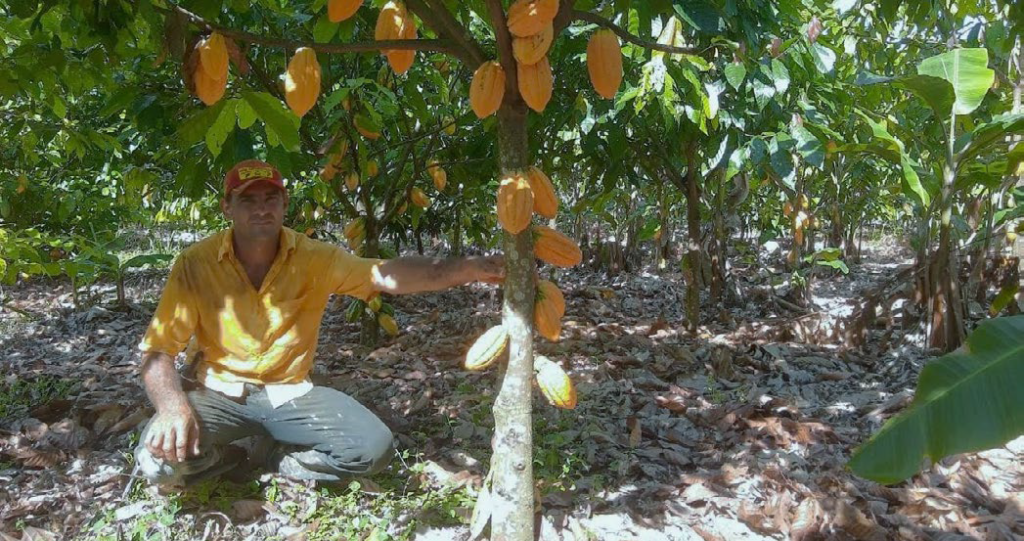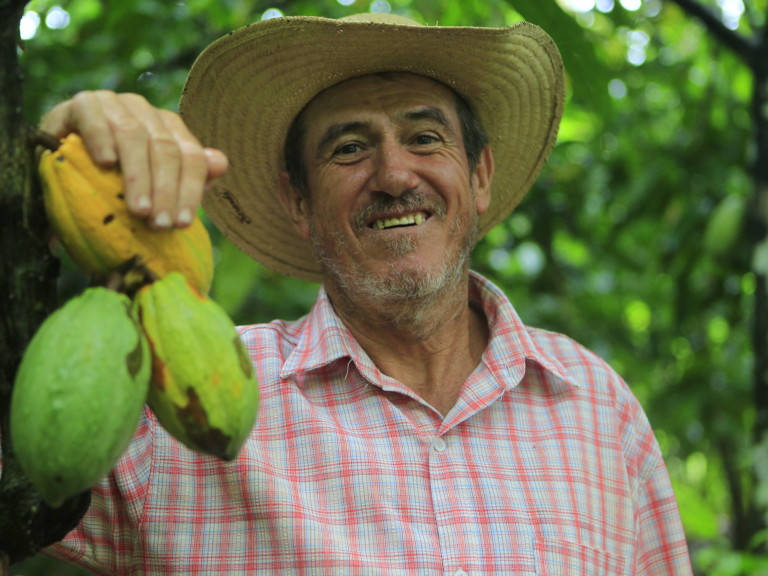With a new career in cocoa, former cattle ranchers in the Amazon are quitting forest clearance and bringing biodiversity back to degraded pasture.
Our latest case study shows how major players across the cocoa value chain are partnering to drive this dual revival of Brazil’s forests and its cocoa sector.

It’s no coincidence that deforestation hotspot Sao Felix do Xingu in Pará State is also Brazil’s top beef-producing region. In the last five years alone, cattle ranching has been the main driver of Pará’s 1.8-million-hectare rainforest loss, an area almost the size of Wales.
In their struggle to make a good income, the region’s many small-scale ranchers feel left with few alternatives to cutting down more forest for grazing cattle. Extensively farmed and no longer able to sustain herds, within a short time exhausted fields are usually abandoned. This practice not only leaves vast swathes of what was once biodiverse forest degraded, but it pushes deforestation deeper into the Amazon and the biome closer to a potentially catastrophic tipping point.
Breaking the cycle
A promising solution to breaking this cycle of degradation is emerging in cocoa agroforestry. An initiative led by The Nature Conservancy (TNC), an international NGO, is supporting ranchers to switch their farmland into agroforestry systems, where they grow cocoa trees – native to the Amazon – in amongst other crops. Through the model, farmers can halt deforestation, actively restore degraded land, and access better livelihood opportunities.
Thriving in the shade of bananas, hardwoods, and other trees, cocoa grown this way could restore up to 130,000 hectares in Pará. The model breathes new life into heavily degraded land with short-cycle crops that provide quick income in their first year – such as corn, cassava, and bananas – and commercial and native tree species that provide shade for cocoa plants – such as crabwood, mahogany, and cedar.

Former cattle rancher Idalto celebrates his third cocoa harvest since joining the project in 2014. Image: Kevin Arnold
Restoring land through cocoa agroforestry brings significant environmental benefits: it maintains soil fertility, boosts biodiversity, and importantly means that farmers can reach compliance with the Brazilian Forest Code. It pays well too. Compared to cattle ranching, incomes for smallholders can be six times higher when producing cocoa this way.
Idalto Mendes Pereira, a rancher turned cocoa producer says he was sceptical at the idea of growing on degraded land at first: “Back then, we thought that cocoa could only be planted in newly deforested land.” But that changed when over the radio he heard TNC’s plan to launch the project on degraded pasture. “That was the key word for me,” he says, “since I had so much unproductive land, I got immediately excited.” After seeing his success, Idalto says that many of his neighbours are now considering making the shift too.
Kickstarting cocoa agroforestry
However, transitioning from cattle ranching to cocoa agroforestry is not without its challenges. Smallholders need to cover large upfront investment costs and learn a whole new set of skills to grow cocoa in an agroforestry system. The former requires access to rural credit, the latter affordable and large-scale technical assistance.
To tackle both hurdles, players from across the cocoa value chain have partnered to form a Technical Assistance Hub for cocoa agroforestry in southeast Pará. Working initially with chocolate giant Mondelēz International, TNC connected with Partnerships for Forests who helped combine a separate initiative with major cocoa supplier Olam Cocoa into the project. Together with local cooperatives and Coordenada Rural, a technical assistance company, the partners shared their varied expertise to pilot the Hub.
Existing technical assistance in the region from both public and private providers is either patchy or expensive, leaving the average cocoa productivity in Pará about half that of well-managed farms. But with combined investment from partners, the project’s self-sustaining Hub offers farmers easily accessible agroforestry and restoration training, plus support in accessing rural credit.
Unlocking credit for producers has been one of the Hub’s major successes. Previously, none of the government subsidised credit for small scale rural producers (PRONAF) went to cocoa agroforestry systems. Working with Banco de Amazônia (BASA), the biggest financier of smallholder agriculture in the Amazon, the TNC-led partnership helped design two new subsidised credit lines for agroforestry in Pará. The Hub supported BASA to more accurately assess risks and more farmers to apply. Already, 34 applications have been approved releasing an unprecedented £230,000 of subsidised credit for cocoa agroforestry.
A sweet deal for farmers and forests
Since launching in 2019, the Hub has trained over 250 smallholders and helped set up over 430 hectares of new agroforestry systems in degraded lands. Farmers have moved away from unsustainable practices, including land clearance, and committed to zero-deforestation and forest restoration on their cocoa farms. So far, they’ve restored 575 hectares in environmentally protected areas.
In return, Olam and Mondelēz International have committed to purchasing cocoa at price premiums via offtake agreements. This model brings mutual benefits: smallholders can earn more for their produce and Olam and Mondelez have access to locally sourced, sustainable, and ethical cocoa which reduces dependency on imports.
The future is looking promising for cocoa agroforestry in the Amazon. As Ilson Martins Silva, founder and Commercial Director at Camppax cooperative representing 235 smallholders, explains: “Today there is more demand [from cattle ranchers] for joining the cocoa scheme than the cooperative can absorb.” What’s more, the governor of Pará State, BASA and TNC have announced a joint strategy to promote a green economy that includes cocoa agroforestry.
Now Olam Cocoa and Mondelēz International are working on a new phase of the project. “We are looking forward to taking this approach at scale to drive lasting change in multiple landscapes”, said Jens Hammer, the Country Lead for Mondelēz Cocoa Life Programme in Brazil. Sharing this enthusiasm, three additional investors – German development agency GIZ, Humanize and Extreme E – are supporting the second phase.
With strong interest from stakeholders across the value chain and a clear pathway to unlock financing, the Hub’s model has potential for much wider scaling and replication. Taking this approach, cocoa agroforestry offers a major opportunity for farmers across the Brazilian Amazon to turn the tide on deforestation and bring thriving ecosystems back to their degraded farms.
Learn more
To learn more about the cocoa agroforestry model and Technical Assistance Hub, please find our case study here.

